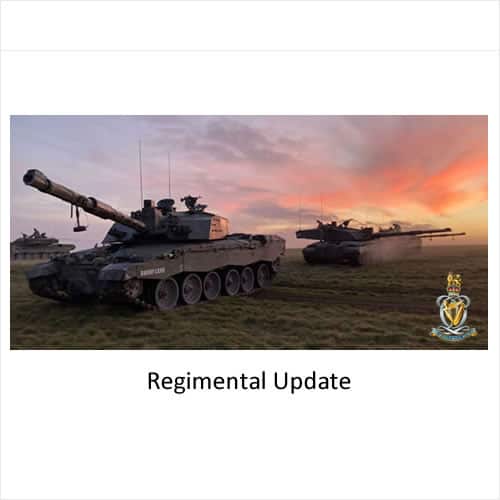Battlegroup Update: December 2019
The last weeks have mercifully seen the temperature rise just a little to a mild but still wet and windy outlook for central Estonia. With the weather hovering around zero but still very wet the conditions have been alas, as much a challenge for the Battlegroup as the tempo.
The first victims of the weather were ‘A’ Squadron on our first exercise, Churchill’s Charger. A combination of wet ground and heavy vehicles proved very testing and the two-day exercise developing low-level drills in a new environment became a hasty masterclass in troop-level recovery. Not to mention a stark reminder to us all that moving anywhere without the REME to pull you out is never a good idea.
It was a steep, but excellent learning curve for the Squadron and other elements of the Battlegroup who had similar experiences on their first outing into the Estonian Forest.
Churchill’s Charger was indeed an opportunity for the Battlegroup at large to deploy out at sub-unit level to get accustomed to local terrain. Recce Troop found themselves spending a productive week mixing tracked and dismounted manoeuvres in the tight woods and tracks South of Tapa Camp.
Several sub-units have also had the opportunity to conduct some live firing over the past two weeks. Small arms ranges combined with Armoured Fighting Vehicle ranges have seen us put our newfound training area to good use, with some hasty templating for 120mm conducted by the training officer! This has included A Squadron’s tanks as well as Recce’s CVR(T) 2.
The temperature plummeted suddenly and some bitterly cold days up on the high firing points of the Central Training Area saw several fires lit and many taking on brisk lessons in bringing as much warm kit as you can find!
As the Battlegroup finds itself looking ever fuller, we continue to have arrivals from the UK. Among them were several ‘A’ Squadron crews who fired through their Challenger 2 ACTs with the KRH on Castle Martin Ranges.
Finally, at full manning in-country, the squadron is hard at work bringing the fleet up to fighting order. The age-old issues with armoured vehicles combined with tricky terrain and cold temperatures will keep everyone busy on the tank park this winter as we keep ourselves ready to defend Estonia should the call come and to deter any potential threats in the meantime.
The latter half of this week has seen the entire Battlegroup prepare for Exercise Furious Cavalry, a six-day exercise moving rapidly from Troop-level training to a full Battlegroup controlled exercise on the central training against the Estonian Scout Battalion.
We are all expecting the Estonians to show us exactly what it feels like to come across well-drilled, cold-weather-hardened soldiers born and trained to fight in woods and forests. But as ever, we are confident that we shall drag ourselves through with the best showing a British armoured Battlegroup can muster.
The week was sadly rounded off with a remembrance service, for our French counterparts, No. 5 Company who form part of our Battlegroup. On Friday morning British and Estonian soldiers joined the French on parade to reflect and commemorate the fourteen of their soldiers who were tragically killed earlier in the week in Mali.
It was a sombre and sobering moment that brought home the realities of military service and the price paid by those who make the ultimate sacrifice.
The Queen’s Royal Hussars Battlegroup took part in a 7-day exercise on the Central Training Area alongside No. 5 Company, our French allies, who formed part of the Battlegroup.
Soldiers from both Estonia’s Regular and Reservist contingents took part in the exercise and provided the enemy throughout the week. The Battlegroup deployed onto the training area using an ALERTEX, proving our ability to respond rapidly to a real-time threat.
The Exercise then started with a series of troop-level battle lanes where we learnt the basics of manoeuvre and how to fight in the restricted, heavily wooded environment. The Battlegroup then split into its respective Combat Teams to undertake two days of integrated training.
This meant that each of the two fighting sub-units, ‘A’ Sqn QRH and ‘B’ Coy 5 RIFLES, had their organic Engineers and Artillery as well as a Troop/Platoon from the other.
This method of combat teaming is much better suited for the type of close terrain out here in Estonia than that which we are used to on the prairies of Canada or open fields of Salisbury Plain.
It was the first opportunity for many QRH soldiers to work closely with the new attached arms. A combination of armour and dismounts proved highly effective at clearing dense woodblocks interspersed with small tracks and clearings.
The Estonians provided us with a complex fight, using small teams of dismounts with anti-armour assets, their CV90 vehicles and a series of minefields and other obstacles in an attempt to constrain our movement.
On a Wednesday evening, the Combat Teams received orders for our first Battlegroup-level operation. The following day, the Battlegroup fought North through the entire training area. No. 5 Coy launched a nighttime insertion that got right into the back of the Estonian Scouts Battalion and caught them off guard. This allowed ‘A’ Sqn and ‘B’ Coy Combat Teams to advance rapidly on two axes and completely unhinge them. They were assisted by a deception force known as ‘Task Force RSM’ that provided the Estonians with yet more dilemmas. The Estonian force was defeated in detail and forced to withdraw.
So decisive was the QRH victory that it resulted in an early finish to the exercise as all the training objectives had been met and we were formally declared as having met our full operating capability.
Capt L Bertram, ‘A’ Squadron Second in Command


